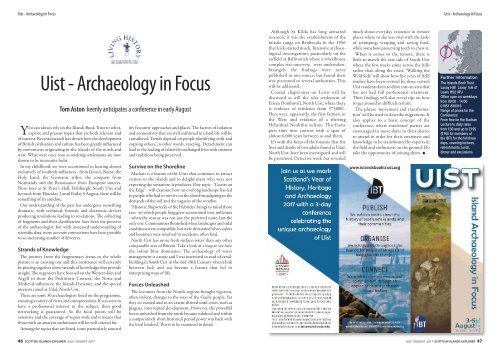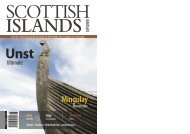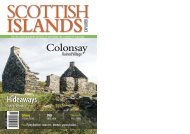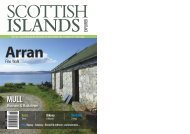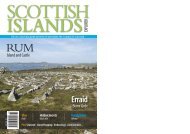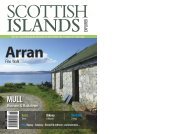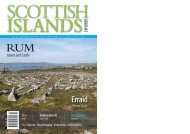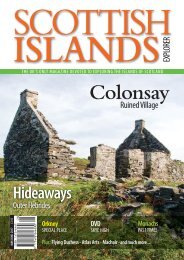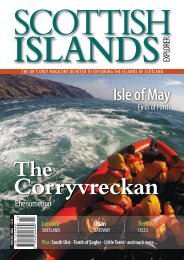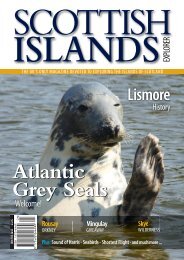Create successful ePaper yourself
Turn your PDF publications into a flip-book with our unique Google optimized e-Paper software.
Uist - Archaeology in Focus<br />
Uist - Archaeology in Focus<br />
Uist - Archaeology in Focus<br />
Tom Aston keenly anticipates a conference in early <strong>Aug</strong>ust<br />
You can always rely on the <strong>Islands</strong> Book Trust to select,<br />
explore and present topics that are both relevant and<br />
of interest. Recent research has shown how the development<br />
of British civilisation and culture has been greatly influenced<br />
by movements originating in the islands of the north and<br />
west. What were once seen as outlying settlements are now<br />
shown to be innovative hubs.<br />
In my childhood, we were accustomed to hearing almost<br />
exclusively of southerly influences - from Greece, Rome, the<br />
Holy Land, the Germanic tribes, the conquest from<br />
Normandy and the Renaissance from European sources.<br />
Now, here at St Peter’s Hall, Daliburgh, South Uist and<br />
beyond, from Thursday 3 until Friday 5 <strong>Aug</strong>ust, there will be<br />
something of an antidote.<br />
Our understanding of the past has undergone something<br />
dramatic, with technical, forensic and electronic devices<br />
producing revolutions leading to revelations. The collecting<br />
of fragments and their classification have been the preserve<br />
of the archaeologist, but with increased understanding of<br />
scientific data, more accurate connections have been possible<br />
to an increasing number of devotees.<br />
Strands of Knowledge<br />
The journey from the fragmentary items to the whole<br />
picture is an exciting one and this conference will certainly<br />
be piecing together those strands of knowledge that provide<br />
insight. The organisers have focused on the Western Isles and<br />
Argyll to show the Prehistoric Context; the Norse and<br />
Medieval influences; the <strong>Islands</strong> Dynamic; and the special<br />
interests raised at Udal, North Uist.<br />
There are some 30 archaeologists listed on the programme,<br />
ensuring a variety of views and interpretations. If you were to<br />
have a professional interest in the subject, then good<br />
networking is guaranteed. So the focal points will be<br />
extensive and the coverage of topics wide and it means that<br />
those with an amateur enthusiasm will be well catered for.<br />
Among the topics that are listed, some particularly aroused<br />
my favourite approaches and places. The factors of isolation<br />
and connectivity that are well enshrined in island life will be<br />
considered. Trends depend on people identifying with and<br />
copying others, in other words, reacting. Detachment can<br />
lead to the leading of relatively unchanged lives with customs<br />
and traditions being preserved.<br />
Survive on the Shoreline<br />
Machair is a feature of the Uists that continues to attract<br />
visitors to the islands and to delight many who were not<br />
expecting the sensations it produces. One topic - ‘Coasts on<br />
the Edge’ - will examine how an evolving landscape has led<br />
to people who had to survive on the shoreline adapting to the<br />
demands of the soil and the vagaries of the weather.<br />
‘Historic Shipwrecks of the Hebrides’ brings to mind those<br />
eras - to which people long grew accustomed over millennia<br />
- when the seaway was not just the preferred route, but the<br />
only one. Communities flourished when landscapes and tidal<br />
conditions were compatible, but were devastated when sailors<br />
and boatmen were involved in accidents, often fatal.<br />
North Uist has more fresh surface-water than any other<br />
comparable area of Britain. Take a look at a map to see how<br />
the colour blue dominates. The archaeology of water<br />
management is a topic and I was interested to read of canalbuilding<br />
in South Uist in the mid-18th Century when a link<br />
between loch and sea became a feature that led to<br />
enterprising ways of life.<br />
Forces Unleashed<br />
The incomers from the Nordic regions brought vigorous,<br />
often violent, changes to the ways of the Gaelic people. Yet<br />
they co-existed and to an extent thrived until crises, such as<br />
plagues, interrupted development. However, the powerful<br />
forces unleashed from the north became subdued and within<br />
a comparatively short historical period power was back with<br />
the local kindred. This is to be examined in detail.<br />
Although St Kilda has long attracted<br />
research, it was the establishment of the<br />
missile range on Benbecula in the 1956<br />
that kick-started much. Intensive archaeological<br />
investigations, particularly on the<br />
airfield at Ballivanich where a wheelhouse<br />
complex was uncovere, were undertaken.<br />
Strangely the findings were never<br />
published in one source, but found their<br />
way piecemeal to several authorities. This<br />
will be addressed.<br />
Coastal chapel-sites on Lewis will be<br />
discussed as will the islet settlement of<br />
Eilean Domhnvill, North Uist, where there<br />
is evidence of residence from 3750BC.<br />
Here were, apparently, the first farmers in<br />
the West and evidence of a thriving<br />
Hebridean Neolithic culture. This frame<br />
puts time into context with a span of<br />
almost 6,000 years between us and them.<br />
It’s with the focus of the forensic that the<br />
lives and deaths of two adults found at Udal,<br />
North Uist, have been investigated and will<br />
be presented. Detective work has revealed<br />
much about everyday existence in remote<br />
places where to eke was vital with the tasks<br />
of scrimping, scraping and saving food,<br />
while somehow preserving teeth to chew it.<br />
When it comes to the remote, there is<br />
little to match the east side of South Uist<br />
where the few tracks come across the hills<br />
rather than along the coast. ‘Walking the<br />
Wild Side’ will show how five years of field<br />
studies have been revived by three retired<br />
Uist residents keen to delve into an area that<br />
has not had full professional treatment.<br />
Their findings will also reveal tips on how<br />
to get around in difficult terrain.<br />
The phrase ‘movement and transformation’<br />
will be used to describe migrations. It<br />
also applies to a basic concept of the<br />
conference, where interested parties are<br />
encouraged to move dates in their diaries<br />
to attend in order for their awareness and<br />
knowledge to be transformed by experts in<br />
the field and enthusiasts on the ground. Do<br />
take the opportunity of joining them.<br />
Further Information<br />
The <strong>Islands</strong> Book Trust<br />
Laxay Hall Laxay Isle of<br />
Lewis HS2 9PJ<br />
Office open on weekdays<br />
from 09:00 - 14:00<br />
01851 830316<br />
Range of prices for the<br />
Conference:<br />
From free for the Buchan<br />
Lecture to daily rates<br />
from £30 and up to £195<br />
(£165 for members of<br />
the IBT) for the full three<br />
days, covering lectures,<br />
refreshments, lunch,<br />
dinner and excursions.<br />
46 SCOTTISH ISLANDS EXPLORER JULY / AUGUST <strong>2017</strong><br />
JULY / AUGUST <strong>2017</strong> SCOTTISH ISLANDS EXPLORER 47


